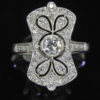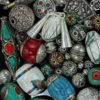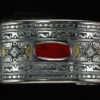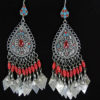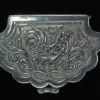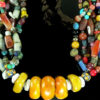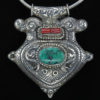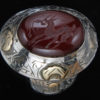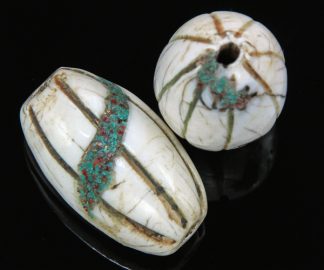The most widely used, of the non precious gems in tribal and ethnic jewellery are coral, turquoise, amber, agate, carnelian, lapis lazuli, malachite, amazonite, onyx and other black stones. While not natural gemstones, glass, ceramics and man made trade beads are also widely used. All these gemstones have been traded and and set into tribal jewellery for thousands of years.
From diamonds to clay, virtually all gemstones used in jewellery have been ‘treated’ or ‘enhanced’ in some way. The most obvious and most accepted form of enhancement is the cutting or shaping and polishing of a gem.
Now days there are many different treatments available, some quite simple such as dyeing, others more complex such as laser treatment. In some cases a treatment has become so routine that dealers take it for granted and it is only when the gem has not been treated that it is disclosed. A classic example of this is the heat treatment of sapphires. This improves the colour and clarity of the sapphire and is standard treatment in perhaps > 95% of all sapphires.
There are of course many treatments used that are not considered normal for a particular gemstone and these treatments will usually have an effect on the gemstone’s value and should be disclosed.
Turquoise.
Turquoise is perhaps the most widely used gemstone in tribal jewellery. It is well know as a bright light blue opaque gemstone with dark veining. It can vary in colour from white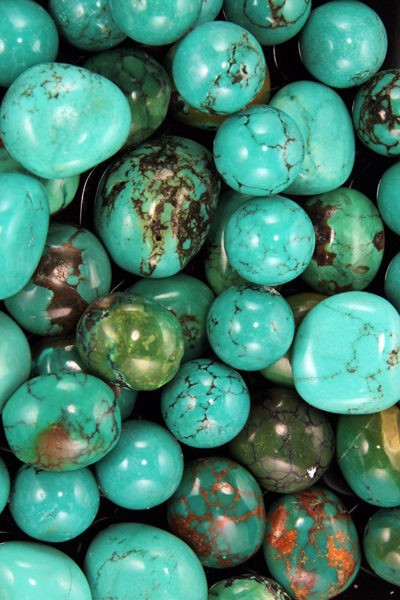 through to shades of blue and green. The most prized gems display a pure vivid light to mid blue colour. However it is more common to find cut gems displaying variations in colour, with attractive veining and numerous patches of host rock material.
through to shades of blue and green. The most prized gems display a pure vivid light to mid blue colour. However it is more common to find cut gems displaying variations in colour, with attractive veining and numerous patches of host rock material.
Turquoise is found in many countries throughout the world. For thousands of years, it has been mined in countries such as Iran, Turkey, the Sinai Peninsula, China, the Himalayas and Afghanistan. It also occurs in South America and the most significant source today is in the South West United States, in Arizona, New Mexico, Colorado, and Nevada. In the US it is the most coveted gemstone used by the silver jewellery making artisans of the indigenous Navajo and Zuni people. Like coral, turquoise is not that hard to identify from imitations once you gain a “feel” for the material, however, it is extremely difficult to distinguish natural from treated material. Using a 10x loop the surface of turquoise displays a consistent smooth colour with fine white spotting and any veining should be random in design.
There is a lot of imitation and treated material available. In most case it arouses suspicion because it looks too good, too consistent in its colour and too repetitive in its veining. The most common imitations of turquoise are either dyed howlite or dyed magnesite. Howlite with similar veining patterns can be tricky, look for dye stains along vein lines. A small drop of HCL acid will cause magnesite to effervesce and howlite to turn green. Glass and plastic is also used as an imitation. Under close examination, bubbles in glass swirling in glass and plastic are often evident, further, the translucency of glass just doesn’t look like real turquoise.
The most common ‘treatment’ of turquoise include ‘reconstitution’ and ‘stabilisation’. Reconstituted turquoise is made by grinding up small pieces of low-quality turquoise which is then pressed and bonded with dyes and resins, (glues), into a sold mass which is then cut into gems. While technically it is turquoise, bonded with glues, in my opinion, reconstituted material should be categorized as an imitation because it is far from natural. Also, some reconstituted ‘turquoise’ is made from cheap alternatives such as howlite or Magnetite which is ground, dyed and bonded and this product is most certainly an imitation. The reconstituted product tends to raise suspicion because it can look too consistent, too good to be true.
Natural turquoise will change and or fade in colour over time and it is often too friable to be cut into a solid gemstone. To counter these problems most turquoise today is ‘stabilized’. Stabilization is a process whereby a resin, epoxy or a glassy substance, (sodium silicate), is impregnated under pressure into the turquoise. This enhances the colour and makes the turquoise more solid and durable. There are varying degrees of stabilization, the most extensive approaches reconstitution in that highly friable low colour material is dyed and bonded together. The least invasive process simply enhances the durability of good coloured reasonably solid material.
The fact is most turquoise today has been treated significantly and one should assume this unless they know it not to be the case. Most untreated natural turquoise today comes from the mines of South West United states, the Sleeping Beauty and Kingman mines are well known examples, understandably this material demands a premium.
Coral.
Like turquoise and amber, red and pink coral has been used by tribal artisans in jewellery for thousands of years, it was a highly prized commodity traded along the ancient Silkroad routes. Like amber and turquoise as well as being pretty coral was believed to posses mythical powers to 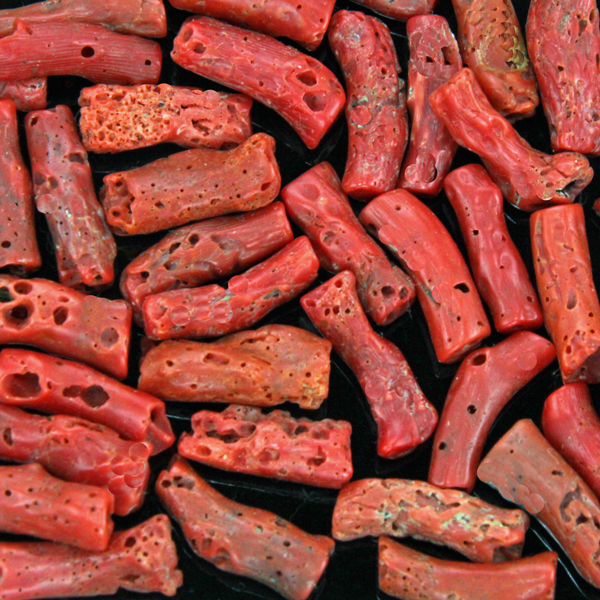 protect and heal.
protect and heal.
For thousands of years coral has been harvested from the Mediterranean sea especially around the Italian and Sardinia coast and along the North African coast in the Mediterranean and Atlantic oceans. More recently it is harvested in deep water around Japan and Taiwan.
While red and pink are the most popular coral is also found in other colours, white, black, and gold being the most common.
Many cultures have used coral, turquoise and amber in their jewellery. They have always been popular with Himalayan people and while I have read that the Tibetans first discovered the beauty of red coral from deposits in the Himalayas I think this is somewhat misleading. Coral, shells and fish bones deposited over millions of years are eventually, compacted by geological forces into limestone. While limestones will exhibit marine life fossils including coral it is not the same as sea coral. Fossil coral while attractive is usually white to brown and looks more like stone than coral. While Himalayan peoples may well have used fossil coral it is not the same as the red and pink sea coral so commonly scene in their jewellery today. The red and pink corals used by the Tibetan and Nepalese people for many hundreds of years came from Silk Road traders, from China and from the rich deposits of the Mediterranean.
Bamboo Coral is commonly used today as a substitute for the now scarce and protected precious red Mediterranean coral. Bamboo Coral, so called because in its natural state it looks like bamboo, grows in deep oceans and is a white in colour with black bands. It is dyed red or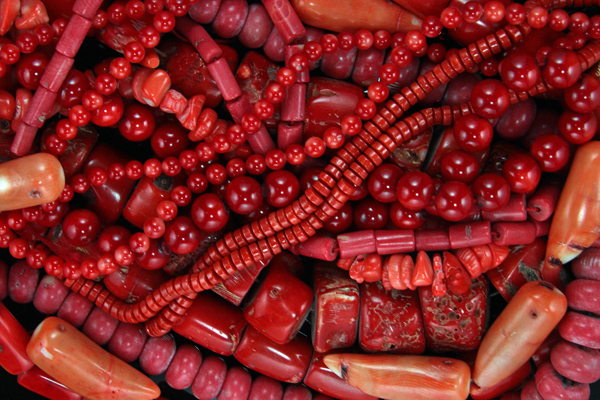 pink to look like precious red or pink coral. today most coral on the market is dyed bamboo coral.
pink to look like precious red or pink coral. today most coral on the market is dyed bamboo coral.
Once one gains a “feel” for coral it tends to be reasonably easy to from its imitations. It usually shows at least some pitting and texture, it is light in weight and even when highly polished does not exhibit a glassy look. Imitations of coral include dyed shell and bone, glass, ceramics and plastics. Reconstituted coral, see turquoise above, is also used.
Corals, shell and bone are made of calcium carbonate and will effervesce if touched by a small drop of hydrochloric acid. A more practical test is to place the piece in vinegar, a weak acid, for just a short time. If bubbles, (effervescence), appear on the surface it shows it is calcium carbonate and therefore may be coral, shell or bone but not glass or plastic. Plastic will melt with a red hot needle and often shows swirl markings. Glass may exhibit tiny bubbles under magnification; it may also show mould or swirl lines but will not show the pitting or texture of coral. Glass being harder also tends to display has a more polished look and unlike coral will not scratch easily.
About amber and copal.
Amber and copal have been burned as incense and used in jewellery for thousands of years. Like coral and turquoise amber was a highly prized commodity traded along the ancient Silk Road routes.
Amber is formed from prehistoric tree resin, (not sap), that has been transformed over tens of millions of years by a process called polymerisation where the resin slowly loses its oils and hardens into the plastic / resinous like substance we know today as amber. Copal is a type of immature amber. It may be 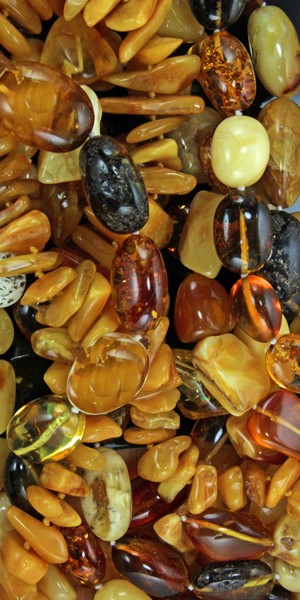 only a few hundred to a few million years old and therefore has not fully undergone the polymerisation process required to create true amber.
only a few hundred to a few million years old and therefore has not fully undergone the polymerisation process required to create true amber.
Amber and copal deposits can be found in many locations throughout the world. The vast majority of amber was and still is mined from the 40 to 50 million year old deposits in the Baltic region of Poland and Russia. Until very recently only copal was found in Africa, historically from Tanzania and the Congo and more recently in Madagascar. Some twelve years ago a 95 million year old amber deposit was discovered in central Ethiopia.
While most people think of amber and copal as a honey coloured transparent substance it also occurs in black, red to plum, shades of green and blue, almost colourless and all shades of yellow, orange and brown. It can vary from clean and transparent to being full of inclusions to opaque. Inclusions may include prehistoric insects or leaves that were caught in the sticky resin when it oozed from its tree.
The most common materials used to imitate amber are various forms of synthetic resins and plastics and horn. Amber is also available as reconstituted, (pressed), amber, see in Turquoise above. It is not easy to distinguish amber or copal from each other or from their imitations. It will usually require the results from several tests to establish a conclusive identification. The most common tests are:- 1. The red hot needle test which will not easily penetrate amber or copal and should create a pleasant wood odour. A red hot needle will usually easily penetrate a plastic, melting and blackening it, giving off a chemical odour. 2. True amber will float in well salted water. Most copal and amber imitations won’t. 3. When rubbed briskly with a cloth amber readily becomes electrostatically charged and will attract small pieces of paper to it, however this can also occur, to a lesser degree, with other materials.
4. A drop or two of Acetone, (nail polish remover), will not, or will barely affect, amber but will dissolve most plastics and copal making them tacky or sticky. 5. Under UV light true amber will glow a yellow, orange, green or blue colour while copal’s glow will be faint and plastic and synthetic resins tend not to glow at all. 6. If you have a refractometer the refractive index or RI of amber and copal is around 1.54
African Amber.
So called “African Amber” is prized by the Berber people of North Africa and collectors of tribal jewellery. Very old, rare examples can be worth thousands 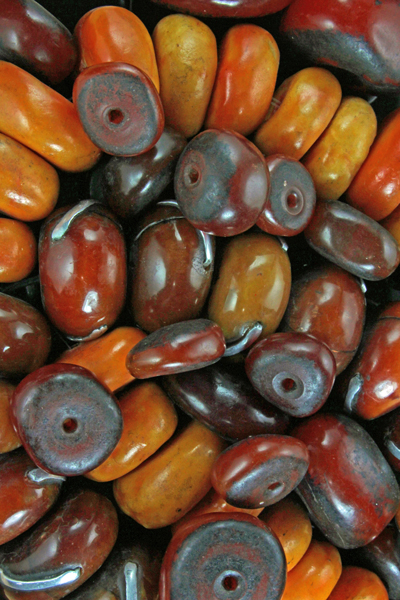 of dollars, however, a word of caution, despite what many sellers and websites would have you believe “African Amber” is almost never true amber nor is it copal, ( see about amber and copal above). From my experience I would guess that greater than 95% of so called “African Amber” is newish man made pieces, made from resins or plastics. It is true that because of its entheogenic history, authentic old African, man made faux amber, can be quite valuable. However it is rarely worth the hundreds or thousands of dollars that some sellers claim. I would suggest you ask for an authentication certificate from a reputable laboratory before buying necklaces or items which are claimed to be real amber or copal.
of dollars, however, a word of caution, despite what many sellers and websites would have you believe “African Amber” is almost never true amber nor is it copal, ( see about amber and copal above). From my experience I would guess that greater than 95% of so called “African Amber” is newish man made pieces, made from resins or plastics. It is true that because of its entheogenic history, authentic old African, man made faux amber, can be quite valuable. However it is rarely worth the hundreds or thousands of dollars that some sellers claim. I would suggest you ask for an authentication certificate from a reputable laboratory before buying necklaces or items which are claimed to be real amber or copal.
Older beads, may crack and are stapled together with white metal strips to stop them from cracking further. This adds to their desirability as it helps to authenticate their history and adds an attractive and interesting look to a bead or necklace. However, once again buyers must be cautious because new beads are also treated in this fashion.
I would advise never to pay large amounts of money for “African Amber” necklaces unless you are absolutely sure about what you are purchasing.
Carnelian, Agate, Onyx and the quartz family
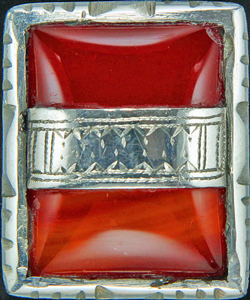
Like Chalcedony these three gems are all colour variations of the same substance, they are all cryptocrystalline quartz. Quartz is made of silica, (SiO2), and it is the most abundant mineral on Earth accounting for a very large group of semi-precious gemstones which are found throughout the world. Quartz can appear in its transparent or crystal form or in its cryptocrystalline, (a mass of microscopic crystals) opaque or mostly translucent form.
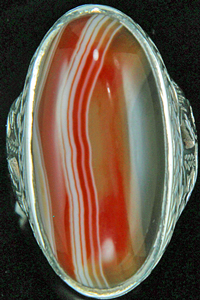 Quartz occurs in many colours, for example, if white it is known as milky quartz, if green it is known as green chalcedony or if green and containing tiny mica specks it is called aventurine. If pink, it’s rose quartz, if purple then amethyst, if orange to orange brown then is called citrine or if an orange red it is known as carnelian, if black it is called onyx. If a specimen displays bands of colour it is known as agate and where silica replaces the original asbestos it can result in Tiger’s Eye.
Quartz occurs in many colours, for example, if white it is known as milky quartz, if green it is known as green chalcedony or if green and containing tiny mica specks it is called aventurine. If pink, it’s rose quartz, if purple then amethyst, if orange to orange brown then is called citrine or if an orange red it is known as carnelian, if black it is called onyx. If a specimen displays bands of colour it is known as agate and where silica replaces the original asbestos it can result in Tiger’s Eye.
All quartzes are reasonable hard and tough stones and therefore can be shaped and well polished so they are most suitable for use in jewellery.
There is often no need to artificially treat the quartzes however heat treatment, dyeing and irradiation to improve the colour is common. Most citrines are the result of heat or irradiation treatments.
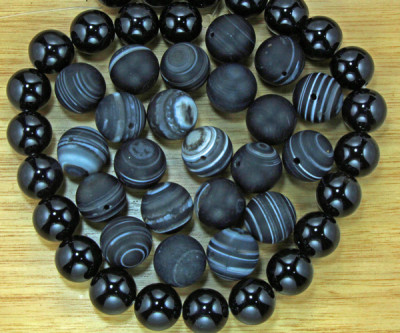
Because quartz gems are quite inexpensive generally when being traded little if no consideration is given to the question of whether they are treated or not.
Lapis Lazuli, Malachite and Amazonite
 Lapis lazuli, also commonly called lapis, is a beautiful mid to dark blue coloured stone made up dominantly of lazurite with varying quantities of other minerals such as sodalite and calcite. In particular lapis is well known for the often bright golden to greyish flecks of pyrite, (fool’s gold), disseminated throughout. Like other tribal jewellery gemstones mentioned above, Lapis has been a popular ornamental and jewellery gemstone for thousands of years; there are many surviving examples from the ancient Egyptian civilizations. It has
Lapis lazuli, also commonly called lapis, is a beautiful mid to dark blue coloured stone made up dominantly of lazurite with varying quantities of other minerals such as sodalite and calcite. In particular lapis is well known for the often bright golden to greyish flecks of pyrite, (fool’s gold), disseminated throughout. Like other tribal jewellery gemstones mentioned above, Lapis has been a popular ornamental and jewellery gemstone for thousands of years; there are many surviving examples from the ancient Egyptian civilizations. It has 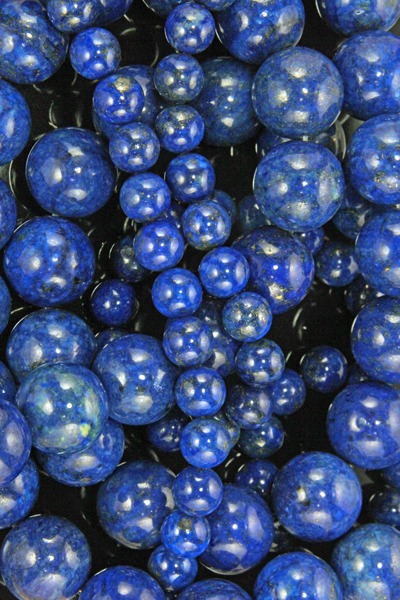 been mined historically to the present day in Afghanistan and Iran and more recently at Lake Baikal in Russia it is also mined in several other countries including the Americas
been mined historically to the present day in Afghanistan and Iran and more recently at Lake Baikal in Russia it is also mined in several other countries including the Americas
Lapis Lazuli treatments include stabilisation, reconstitution and dyeing as discussed with turquoise, see above. However as good quality lapis is still relatively plentiful treatment or enhancement is not so common.
Malachite
is a beautiful mid to dark green copper carbonate stone which usually exhibits circular, (botryoidal), and wave like colour banding. It is often associated with a beautiful dark blue stone, of similar composition, called Azurite which looks similar to lapis lazuli without the flecks.
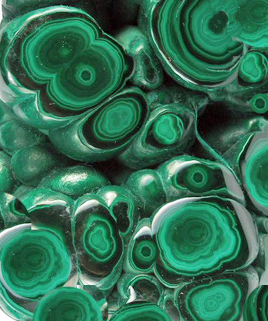
Malachite is associated with copper deposits and is found throughout the world. Surprisingly malachite is not so commonly seen in tribal jewellery perhaps because it is relatively soft and therefore scratches quite easily. It has however always been popular as an ornamental stone sometimes being carved into enormous ornaments or sculptures, measuring metres in dimension.
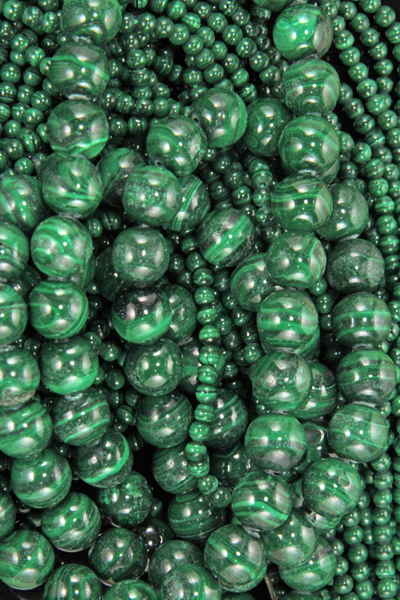
Malachite is rarely treated because good quality specimens are still plentiful however it is sometimes subjected to stabilisation and dyeing.
Amazonite
varies in colour from a light to mid greeny blue with a vague white 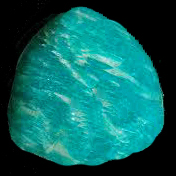 mottled appearance; it is usually opaque in tribal jewellery but also can occur in a translucent form. It belongs to the huge and prolific group of minerals called feldspars.
mottled appearance; it is usually opaque in tribal jewellery but also can occur in a translucent form. It belongs to the huge and prolific group of minerals called feldspars.
Historically Amazonite was mined from the Ilmen Mountains in Russia which accounts for its use in Middle Eastern tribal jewellery. It also occurred in smaller deposits throughout the ancient world. Like other tribal gemstones it was used by the ancient Egyptians and in North African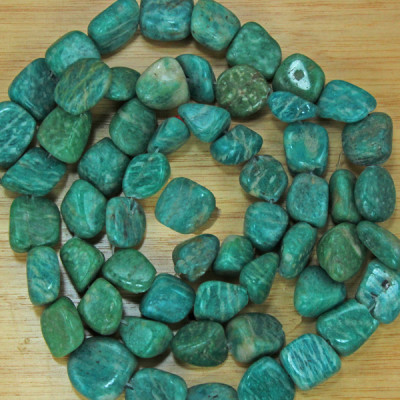 tribal jewellery.
tribal jewellery.
Amazonite is not a valuable semi –precious gemstone, consequently it is rarely, if ever, subjected to enhancement treatments.
As always your comments and or questions are most welcome.

